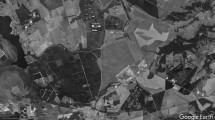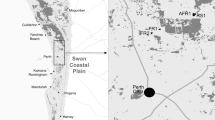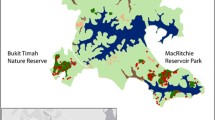Abstract
The manner by which pollinators move across a landscape and their resulting preferences and/or avoidances of travel through particular habitat types can have a significant impact on plant population genetic structure and population-level connectivity. We examined the spatial genetic structure of the understory tree Cornus florida (Cornaceae) adults (N Adults = 452) and offspring (N Offspring = 736) across two mating events to determine the extent to which pollen pool genetic covariance is influenced by intervening forest architecture. Resident adults showed no spatial partitioning but genotypes were positively autocorrelated up to a distance of 35 m suggesting a pattern of restricted seed dispersal. In the offspring, selfing rates were small (sm = 0.035) whereas both biparental inbreeding (s b;open canopy = 0.16, s b;closed canopy = 0.11) and correlated paternity (r p;open canopy = 0.21, r p;closed canopy = 0.07) were significantly influenced by primary canopy opening above individual mothers. The spatial distribution of genetic covariance in pollen pool composition was quantified for each reproductive event using Pollination Graphs, a network method based upon multivariate conditional genetic covariance. The georeferenced graph topology revealed a significant positive relationship between genetic covariance and pollinator movement through C. florida canopies, a negative relationship with open primary canopy (e.g., roads under open canopies and fields with no primary canopy), and no relationship with either conifer or mixed hardwood canopy species cover. These results suggest that both resident genetic structure within stands and genetic connectivity between sites in C. florida populations are influenced by spatial heterogeneity of mating individuals and quality of intervening canopy cover.



Similar content being viewed by others
References
Albert R, Barabasi AL (2002) Statistical mechanics of complex networks. Rev Modern Phys 74:47–97
Austerlitz F, Dick CW, Dutech C, Klein EK, Oddou-Muratorio S, Smouse PE, Sork VL (2004) Using genetic markers to estimate the pollen dispersal curve. Mol Ecol 13:937–954
Bacles CFE, Lowe AJ, Ennos RA (2006) Effective seed dispersal across a fragmented landscape. Science 311:628
Barabási AL, Albert R (1999) Emergence of scaling in random networks. Science 286:251–262
Cabe PR, Liles JS (2002) Dinucleotide microsatellite loci isolated from flowering dogwood (Cornus florida L.). Mol Ecol Notes 2:150–152
Cain ML, Damman H, Muir A (1998) Seed dispersal and the holocene migration of woodland herbs. Ecol Monogr 68:325–347
Carlquist S (1967) The biota of long-distance dispersal. V: plant dispersal to Pacific islands. Bull Torrey Botanical Club 94:129–162
Carr D (2010) Canopy disturbance and reproduction in Cornus florida L. Masters Thesis, Virginia Commonwealth University. http://hdl.handle.net/10156/3078
Craft KJ, Ashley MV (2010) Pollen-mediated gene flow in isolated and continuous stands of bur oak, Quercus macrocarpa (Fagaceae). Am J Bot 97:1999–2006
Cushman SA, Lewis JS (2010) Movement behavior explains genetic differentiation in American black bears. Landscape Ecol 25:1613–1625
Cushman SA, McKelvey KS, Hayden J, Schwartz MK (2006) Gene flow in complex landscapes: testing multiple hypotheses with causal modeling. Am Nat 168:486–499
de Moraes MLT, Sebbenn AM (2011) Pollen dispersal between isolated trees in the Brazilian Savannah: a case study of the neotropical tree Hymeneae stigonocarpa. Biotropica 43:192–199
Devaux C, Lavigne C, Austerlitz F, Klein EK (2007) Modeling and estimating pollen movement in oilseed rape (Brassica napus) at the landscape scale using genetic markers. Mol Ecol 16:487–499
Dyer RJ (2007) The evolution of genetic topologies. Theor Popul Biol 71:71–79
Dyer RJ (2009) GeneticStudio: a suite of programs for the spatial analysis of genetic marker data. Mol Ecol Resour 9:110–113
Dyer RJ, Nason JD (2004) Population Graphs: the graph theoretic shape of genetic structure. Mol Ecol 13:1713–1727
Dyer RJ, Sork VL (2001) Pollen pool heterogeneity in shortleaf pine, Pinus echinata Mill. Mol Ecol 10:859–866
Dyer RJ, Westfall RD, Sork VL, Smouse PE (2004) Two-generation analysis of pollen flow across a landscape V: a stepwise approach for extracting factors contributing to pollen structure. Heredity 92:204–211
Dyer RJ, Nason JD, Garrick RC (2010) Landscape modeling of gene flow: improved power using conditional genetic distance derived from population networks. Mol Ecol 19:3746–3759
Ellstrand NC, Marshall DL (1985) Interpopulation gene flow by ollen in wild radish, Raphanus sativus. Am Nat 126:606–610
Ennos RA (1994) Estimating relative rates of pollen and seed migration among plant populations. Heredity 72:250–259
Eriksson O (1996) Regional dynamics of plants: a review of evidence for remnant source-sink and metapopulations. Oikos 77:248–258
Fagan WF, Cantrell RS, Cosner C (1999) How habitat edges change species interactions. Am Nat 153:165–182
Fernandez-Manjarres JF, Idol J, Sork VL (2006) Mating patterns of black oak, Quercus velutina (Fagaceae) in a Missouri oak-hickory forest. J Hered 97:451–455
Fortuna MA, Garcia C, Guimaraes PR, Bascompte J (2008) Spatial mating networks in insect-pollinated plants. Ecol Lett 11:490–498
Fuchs EJ, Hamrick JL (2011) Mating system and pollen flow between remnant populations of the endangered tropical tree, Guaiacum sanctum (Zygophyllaceae). Conserv Genet 12:175–185
Gardiakos VA (2009) Pollen-mediated gene movement in flowering dogwood, Cornus florida L. Masters Thesis, Virginia Commonwealth University
Geffen E, Anderson MJ, Wayne RK (2004) Climate and habitat barriers to dispersal in the highly mobile grey wolf. Mol Ecol 13:2481–2490
Grass Development Team (2008) Geographic Resources Analysis Support System (GRASS) Software. Open source geospatial foundation project. http://grass.osgeo.org
Hedrick PW (2005) A standardized genetic differentiation measure. Evolution 59:1633–1638
Higgins SI, Richardson DM (1999) Predicting plant migration rates in a changing world: the role of long-distance dispersal. Am Nat 153:464–475
Holzhauer SIJ, Ekschmitt K, Sander AC, Dauber J, Wolters V (2006) Effects of historic landscape change on the genetic structure of the bush-cricket. Landscape Ecol 21:891–899
Husband BC, Barrett SCH (1996) A metapopulation perspective in plant population biology. J Ecol 84:461–469
Iwaizumi MG, Takahashi M, Watanabe A, Ubukata M (2010) Simultaneous evaluation of paternal and maternal immigrant gene flow and the implications for the overall genetic composition of Pinus densiflora dispersed seeds. J Hered 101:144–153
Keller EF (2005) Revisiting ‘scale-free’ networks. BioEssays 27:1060–1068
Machado ICS, Sazima I, Sazima M (1998) Bat pollination of the terrestrial herb Irlbachia alata (Gentianaceae) in northeastern Brazil. Plant Syst Evol 209:231–237
Manel S, Schwrtz MK, Luikart G, Taberlet P (2003) Landscape genetics: combining landscape ecology and population genetics. Trends Ecol Evol 18:189–197
Mayor AJ, Grant JF, Windham MT, Trigiano RN (1999) Insect visitors to flowers of flowering dogwood, Cornus florida L., in eastern Tennessee: potential pollinators. South Nurseries Assoc Res Conf 44:192–196
McRae BH (2006) Isolation by resistance. Evolution 60:1551–1561
Meagher TR, Vassiliadis C (2003) Spatial geometry determines gene flow in plant populations. In: Hails R, Beringer J, Godfray HC (eds) Genes in environment: 15th special symposium of the British Ecological Society. British Ecological Society, London
Moran EV, Clark JS (2011) Estimating seed and pollen movement in a monoecious plant: a hierarchical Bayesian approach integrating genetic and ecological data. Mol Ecol 20:1248–1262
Murphy MA, Dezzani R, Pilliod DS, Storfer A (2010) Landscape genetics of high mountain frog metapopulations. Mol Ecol 19:2624–2649
Nielsen R, Mattila DK, Clapman PJ, Palsbøll PJ (2001) Statistical approaches to paternity analysis in natural populations and applications to the North Atlantic Humpback Whale. Genetics 157:1673–1682
Nigel JE (1997) A comparison of alternative strategies for estimating gene flow from markers. Ann Rev Ecol Syst 28:105–128
Oddou-Muratorio S, Bontemps A, Klein EK, Chybicki I, Vendramin GG, Suyama Y (2010) Comparison of direct and indirect genetic methods for estimating seed and pollen dispersal in Fagus sylvatica and Fagus crenata. For Ecol Manag 259:2151–2159
Ohashi K, Thomson JD (2009) Trapline foraging by pollinators: its ontogeny, economics, and possible consequences for plants. Ann Bot 103:1365–1378
Ohashi K, Thomson JD, D’souza D (2007) Trapline foraging by bumble bees: IV. Optimization of route in the absence of competition. Behav Ecol 18:1–11
Ohashi K, Alison L, Thomson JD (2008) Trapline foraging by bumble bees: V. Effects of experience and priority on competitive performance. Behav Ecol 19:936–948
Okubo A, Levin SA (1989) A theoretical framework for data analysis of wind dispersed seed and pollen. Ecology 70:329–338
Pluess AR, Sork VL, Dolan B, Davis FW, Grivet D, Merg K, Papp J, Smouse PE (2009) Short distance pollen movement in a wind-pollinated tree, Quercus lobata (Fagaceae). For Ecol Manag 258:735–744
Pritchard JK, Stephens M, Donnelly P (2000) Inference of population structure using multilocus genotype data. Genetics 155:945–959
Radford AE, Ahles HE, Bell CR (1968) Manual of the vascular plants of the Carolinas. The University of North Carolina Press, Chapel Hill
Rayfield B, Fortin MJ, Fall A (2010) The sensitivity of least-cost habitat graphs to relative cost surface values. Landscape Ecol 25:519–532
Ritland K (2002) Extensions of models for the estimation of mating systems using N independent loci. Heredity 88:221–228
Robledo-Arnuncio JJ, Gil L (2005) Patterns of pollen dispersal in a small population of Pinus sylvestris L. revealed by total-exclusion paternity analysis. Heredity 94:12–22
Robledo-Arnuncio JJ, Austerlitz F, Smouse PE (2006) A new method of estimating the pollen dispersal curve independently of effective density. Genetics 173:1033–1045
Schnabel AR, Nason JD, Hamrick JL (1998) Understanding the population genetic structure of Gleditsia triacanthos L.: seed dispersal and variation in female reproductive success. Mol Ecol 7:819–832
Shaw R (2009) Shrinking the Janzen-Connell Doughnut: Consequences of an invasive multiplier (Microstegium vimineum) on the mid-canopy in a mixed pine-oak forest. Masters Thesis, Virginia Commonwealth University. http://hdl.handle.net/10156/2491
Skellam JG (1951) Random dispersal in theoretical populations. Biometrika 38:196–218
Slatkin M (1985) Gene flow in natural populations. Ann Rev Ecol Syst 16:393–430
Smouse PE, Peakall R (1999) Spatial autocorrelation analysis of individual multiallele and multilocus genetic structure. Heredity 82:561–573
Smouse PE, Sork VL (2004) Measuring pollen flow in forest trees: a comparison of alternative approaches. For Ecol Manag 197:21–38
Smouse PE, Dyer RJ, Sork VL, Westfall RD (2001) Two-generation analysis of pollen movement across a landscape I: male gamete heterogeneity among females. Evolution 55:260–271
Sorensen AE (1986) Seed dispersal by adhesion. Ann Rev Ecol Syst 17:443–463
Sork VL, Smouse PE (2006) Genetic analysis of landscape connectivity in tree populations. Landscape Ecol 21:821–836
Sork VL, Nason JD, Campbell DR, Fernandez JF (1999) Landscape approaches to historical and contemporary gene flow in plants. Trends Ecol Evol 14:219–224
Sork VL, Davis FW, Smouse PE, Apsit VJ, Dyer RJ, Fernandez-Manjarres JF, Kuhn B (2002) Pollen movement in declining populations of California Valley oak, Quercus lobata: where have all the fathers gone? Mol Ecol 11:1657–1668
Sork VL, Smouse PE, Apsit VJ, Dyer RJ, Westfall RD (2004) A two-generation analysis of pollen pool genetic structure in flowering dogwood, Cornus florida (Cornaeceae), in the Missouri Ozarks. Am J Bot 92:262–271
Thomson JD, Peterson SC, Harder LD (1987) Response of traplining bumble bees to competition experiments: shifts in feeding location and efficiency. Oecologia 71:295–300
Waddington CH (1957) The strategy of the genes. George Allen and Unwin Publishers, Crows Nest
Wang IJ, Savage WK, Bradley-Shaffer H (2009) Landscape genetics and least-cost path analysis reveal unexpected dispersal routes in the California tiger salamander (Amybstoma californiense). Mol Ecol 18:1365–1374
Wang J, Kang M, Gao PX, Huang HW (2010) Contemporary pollen flow and mating patterns of a subtropical canopy tree Eurycorymbus cavaleriei in a fragmented agricultural landscape. For Ecol Manag 260:2180–2188
White GM, Boshier DH, Powell W (2002) Increased pollen flow contracts fragmentation in a tropical dry forest: an example from Swietenia humilis Zuccarini. Proc Nat Acad Sci (USA) 99:2038–2042
Young JA, Young CG (1994) Seeds of woody plants of North America. Dioscorides Press, Portland
Young AG, Merriam HG, Warwick SI (1993) The effects of forest fragmentation on genetic variation in Acer saccharum Marsh (sugar maple) populations. Heredity 71:277–289
Acknowledgments
This work was supported by a grant from the National Science Foundation (DEB-0640803) to RJD and DMC. Both VAG and CAM were supported in part by graduate research grants from the Rice Center for Environmental Studies. The authors would also like to thank Jennifer Cimminelli, Will Shuart, and the Center for Environmental Science at Virginia Commonwealth University for assistance with spatial modeling analyses. This manuscript is the Virginia Commonwealth University Rice Center Contribution #18.
Author information
Authors and Affiliations
Corresponding author
Rights and permissions
About this article
Cite this article
Dyer, R.J., Chan, D.M., Gardiakos, V.A. et al. Pollination graphs: quantifying pollen pool covariance networks and the influence of intervening landscape on genetic connectivity in the North American understory tree, Cornus florida L.. Landscape Ecol 27, 239–251 (2012). https://doi.org/10.1007/s10980-011-9696-x
Received:
Accepted:
Published:
Issue Date:
DOI: https://doi.org/10.1007/s10980-011-9696-x




